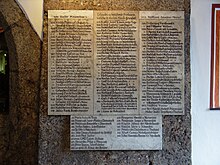Hotel Goldener Adler (Innsbruck)
The Hotel Goldener Adler is a hotel in the old town of Innsbruck and is one of the oldest and most historic hotels in Europe.
history
Since it was founded in 1390, all the many truckers and merchants who came to rest and lodge on their journeys between Italy and Germany have been welcomed here. It is no coincidence that this inn in Innsbruck has been visited by more important personalities over the centuries than any other inn on the old connecting road.
Historical people as guests
The eagle was already known at the time of Emperor Maximilian I. Emperor Charles V , who could say of himself that the sun doesn't set in his empire, is said to have strengthened himself here on April 6, 1552 as a fleeing rider through Tyrol.
The following major event is documented in writing: One of the “most princely collieries” in this inn was made in February 1573 when Archduke Ferdinand II of Tyrol, husband of the beautiful Philippine Welser , invited them to a large festival shooting. For the "big stop" of the entourage, who numbered 416 people and 580 horses, the then Adlerwirt collected 1,800 guilders. Apparently he also took care of accommodating the huge number of foreign guests outside of their own home.
Emperor Joseph II had a long journey behind him when, on his return from Paris, where he had visited his sister Marie Antoinette , on July 29, 1777, he drove through the old inner gate into the city of Innsbruck. He stayed as Count Falkenstein in the Golden Eagle and impressed the Innsbruckers with his winning affability. From the wall of the “Kaiser-Joseph-Stube” his picture looks out over the future generations of guests.
The Golden Eagle was so well known that Leopold Mozart had a room reserved for himself and his famous son Wolfgang in January 1773 in Milan.
Prince-poet Johann Wolfgang von Goethe came to this house twice. The first time Goethe stopped for lunch on September 8, 1786 on his first trip to Italy in the Golden Eagle and talked to the host's young son, in whom he saw the "real Söller" from one of his works. An oil painting in the hotel entrance commemorates this encounter. Four years later, Goethe, accompanied by Duchess Amalie of Saxe-Weimar, stayed at the Golden Eagle for two days. The “Goethestube” later became a meeting place for Tyrolean poets, painters and musicians.
The golden eagle also played a role in the wars of liberation in Tyrol in 1809. The folk hero Andreas Hofer lived here after his first victory over the Napoleonic troops, and from the first floor of the house the freedom fighter addressed his dear “Spruggers” on August 15, 1809: “I won't leave, so true Andrä Hofer hoass. I said it, I saw it, beware of God! "
After the war noise of the Napoleonic era, the eagle also led a tranquil existence. King Ludwig I of Bavaria was a guest several times. In 1828 the magic violinist Niccolò Paganini stayed here and scribbled his name on a window pane of the room he lived in.
One of the earliest portrayers of Tyrol, the Englishman HD Inglis, wanted to go to the "sun" when he visited Innsbruck and got caught in the eagle by mistake, but is said not to have regretted it.
The marble guest table in the eagle arbor bears witness to the visits of other guests from the realm of science and art.
specialty
The best-known specialty of the house is the Tyrolean braised roast made from an old house recipe.
today
For the anniversary celebration of its 600th anniversary in 1990, the Goldene Adler was equipped with the most modern hotel comforts, taking into account the tradition of the house.
Web links
Coordinates: 47 ° 16 ′ 5.8 " N , 11 ° 23 ′ 33.1" E


